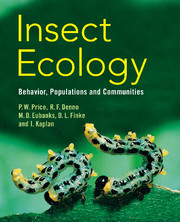Book contents
- Frontmatter
- Contents
- Preface
- Acknowledgments
- Part I Introduction
- Part II Behavioral ecology
- Part III Species interactions
- 4 Plant and herbivore interactions
- 5 Lateral interactions: competition, amensalism and facilitation
- 6 Mutualisms
- 7 Prey and predator interactions
- 8 Parasite and host interactions
- Part IV Population ecology
- Part V Food webs and communities
- Part VI Broad patterns in nature
- Glossary
- References
- Author Index
- Taxonomic Index
- Subject Index
- Plate section
- References
6 - Mutualisms
from Part III - Species interactions
Published online by Cambridge University Press: 05 June 2012
- Frontmatter
- Contents
- Preface
- Acknowledgments
- Part I Introduction
- Part II Behavioral ecology
- Part III Species interactions
- 4 Plant and herbivore interactions
- 5 Lateral interactions: competition, amensalism and facilitation
- 6 Mutualisms
- 7 Prey and predator interactions
- 8 Parasite and host interactions
- Part IV Population ecology
- Part V Food webs and communities
- Part VI Broad patterns in nature
- Glossary
- References
- Author Index
- Taxonomic Index
- Subject Index
- Plate section
- References
Summary
Mutualism is the association of two species, which is beneficial to both: a plus–plus relationship (see also Bronstein et al. 2006). Such species may live in close association through much of their lives, in which case the relationship qualifies as symbiotic mutualism. Some would argue that symbiosis involves the physiological integration between partners, but this criterion is not employed in most of the ecological literature. Examples include the many cases of microbial symbionts of insects, as in termites and their protozoan and bacterial associates. But mutualisms need not be symbiotic, with each species living a life of its own, as with plants and pollinators while, nevertheless, providing services to the other species. Mutualists may be obligate: a necessary association required for the survival and reproduction of a species, as with termites and microbial associates. They may be facultative – beneficial, but not essential for survival and reproduction. An interesting case of a facultative mutualism is the link between stick insects and ants in Australia, in which eggs of phasmids are dropped from the tree canopy to the ground. The capitula on the eggs are attractive to ants, which carry eggs into their nests and to greater protection against natural enemies (Hughes and Westoby 1992). In Costa Rica ants disperse eggs, but do not carry them deep into the nest (Windsor et al. 1996).
We will explore the rich array of mutualistic interactions, recognizing the evolutionary opportunities generated by reciprocal beneficial associations, and the many forms of mutualism involving insects. Then we will enter into the subject of the inevitable costs and benefits of these associations, and cheating the system. Mutualistic relationships have resulted in major adaptive radiations, which we explore with several examples, and then move on to approaches to modeling and how beneficial relationships may become complex and central to community organization, as well as in the practice of agriculture.
- Type
- Chapter
- Information
- Insect EcologyBehavior, Populations and Communities, pp. 224 - 267Publisher: Cambridge University PressPrint publication year: 2011



